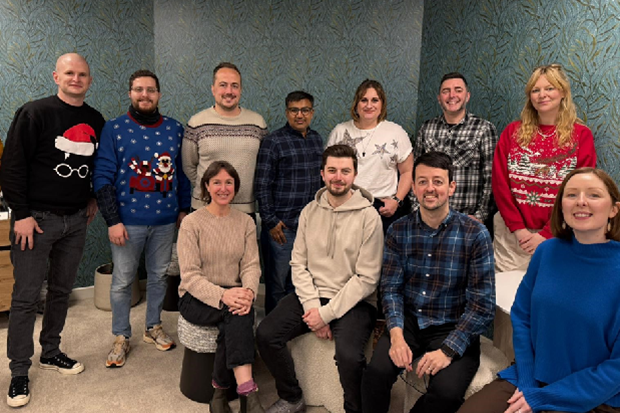
It’s been a busy year for Defra Forms. Lead Product Manager Jenny Taylor and Senior Content Designer Anna Scott reflect on the story so far, lessons learnt and reaching the exciting step of rolling out forms guidance and tools access to more users within Defra Group
The Defra Forms project aims to tackle Defra Group’s reliance on paper-based forms. By transitioning to online forms, we want to enhance user experience, streamline processes, and improve overall efficiency. Our vision is to make it easier, quicker, and simpler for users to send information to Defra.
Last year, we explored whether we could deliver one solution for many problems – could we deliver tech capability to complement GOV.UK Forms, that could work across multiple applications and systems across Defra Group, and meet Defra-specific needs?
Since then, we’ve developed a tool that can be used to create forms quickly and easily: the Digital Express Toolkit (DXT). Alongside this, we’ve adopted GOV.UK Forms for forms that don’t require the Defra-specific features that DXT accommodates. Together, these tools help us meet a wide range of user needs across Defra, which is a broad and complex department.
Part of Defra’s digital transformation strategy
The Defra Forms project is an integral part of Defra’s Digital and Data Transformation Strategy. The strategy reflects:
“our collective ambition for people to interact with us with greater confidence and ease, whenever and wherever they engage with Defra Group, and to access seamless, better, more integrated services”.
The Defra Forms project has the remit not only to provide the technology but also the potential operating model for delivering online forms without always needing a team of digital specialists.
Where we’re up to with DXT
During Private Beta, we’ve tested and iterated DXT with Defra content designers. We’ve also been using the tool ourselves to digitise complex forms with partners across Defra Group.
In doing so, we’ve been able to publish online forms on GOV.UK that meet our legal and government standards and are much more accessible to users than the existing paper (document based) forms.
Using the tools ourselves to digitise forms: an unscalable solution
Alongside designing and developing DXT, we have been functioning as a small forms consultancy, using DXT and GOV.UK Forms to digitise forms from across Defra Group. Obviously, it’s been a challenge to do this while the tech was still in development, but being ‘super users’ has given us good insights. As we have analysed our own process and outputs, we’ve found that this set up is unscalable for a few reasons:
- The process to digitise forms is much lengthier than we’d thought. From initial exploration with form owners, to drafting, designing, testing and approval, numerous unforeseen obstacles can arise. For example, legislation may change or be delayed, or our internal customers may disengage due to competing priorities.
- Digitising forms isn’t just a content job. Paper forms often need some process or service redesign before they can be made into an online form and be simple to use and accessible for Defra’s diverse range of users.
- By focusing on forms as they’re requested ad-hoc, we aren’t spending enough time thinking more holistically about the service Defra Group needs us to provide. We’re not getting the breadth or depth of user insights we need to inform what we prioritise next and how we meet other user needs around data handling and processing.
- There is hesitation among some colleagues about using a product that is still in development. While there are plenty of features in our product backlog, there is plenty of value that can be released now. To draw an analogy, imagine it is the year 2000 and our users are turning down a mobile phone because they're holding out for a smart phone. We’ve identified a need to provide colleagues with support in adopting continuous improvement as an approach, and to demonstrate that continuous improvement is better than delayed perfection.
It was always our plan to roll out the use of our tools beyond our own small team. However, these insights are really helpful for us as we begin to trial this, and think about what DXT and GOV.UK Forms user groups may look like across Defra Group, and the support they’d need.
Onboarding our first users
We’re excited to have recently given DXT access to its first users outside of our team. Colleagues in the APHA Apps and Permissions service team – a content designer, interaction designer and service designer – used DXT to create a form themselves, with some support from our team. We gave them an initial demo of the tool, and answered a few questions along the way.
This increased our confidence in rolling the tool out to its next internal users, once we’ve taken our next steps: to improve the user interface and develop supporting guidance.
Improving the user interface
We’re in the process of updating the front-end of DXT, which will make it a lot more user friendly and accessible. These changes are informed by several rounds of usability testing as well as an accessibility audit.
Developing guidance
We’re also developing guidance for DXT users. We have run a survey with content designers across government to understand their preferred learning styles for this kind of software. We’ve also conducted a card-sort and tree test to understand how our guidance topics could best be grouped.
Delivering benefits
Better ways to handle and process data
With form validation, embedded guidance and conditional routing, we’re ensuring that information submitted by members of the public is standardised, formatted consistently and accurate. This saves time for users, and time for Defra teams. But we have bigger ambitions: we want to go much further to help Defra handle and process data more efficiently.
There’s clear demand for data submitted in forms to be consumed by other systems within Defra and in other formats. We plan to research and design what this could look like.
Improving user experience and Defra processes
In a recent blog, Content Designer Alice Wilson says how impactful our service has been for the “Apply for a County Parish Holding Number” service. This was great to hear because, as well as giving the public a better user experience, we want to give users within Defra a better experience in establishing digital services – they don’t necessarily need a full delivery team or a lengthy business case to get started, we’re making it faster and easier to establish digital channels with users.
We’ll update soon on the progress Defra Forms is making to strengthening the partnerships we have with other directorates and Arm’s Length Bodies (ALBs) across Defra group and how we are thinking differently about measuring success.
Follow Jenny Taylor, Anna Scott and Defra Digital, Data, Technology and Security on LinkedIn

3 comments
Comment by Robin Knipe posted on
Did anyone stop to ask "why would we create digital forms!?"
The form is a convention of our ancient bureaucratic paper-based information systems, it is inherently crippled by the limitations of such systems. Before starting to digitise, why constrain the potential of your discovery by placing such limitations on the project!? Instead embrace User Centred Design (not Bureaucrat Centred Design), and see the ways data flows through existing systems unencumbered by forms. Ask fundamental questions: what data do we actually need, does it already exist (probably, so where), can existing data simply be shared, what is the smallest possible input we can have from our user base?
If you're producing well designed, well connected services, the need for any user interaction (especially by way of a form) should be basically ZERO! Your aim should not be to preserve the horror and inefficiency of forms - confine this unloved, inferior paradigm to the history books - instead focus on making sure you're using modern technology to its proper potential.
Comment by Anna Scott posted on
Hi there, thanks for your comment.
A lot of what you mention are things we have already taken into consideration during the earlier phases of the project, and are implementing now.
We have been supporting teams to make their forms digital-first in the ways you suggest – by understanding the flow of data, and coaching teams to ask only for the information they need to make a decision or fulfil a transaction. The form building software then supports the team to ask for information in the right way, with conditional settings meaning users only have to answer relevant questions. We have a full team of user-centred design and delivery professionals working on this.
While the ultimate goal is a government department where all services are connected and digitally-enabled, we recognise that it will take a long time to reach that. Our aim is to provide tools that help service teams in Defra take practical, meaningful steps towards better services, driven by the needs of users.
Comment by Robin Knipe posted on
Sounds good.
Having experienced services from other European government bodies, I still find the simplicity and consistency of gov.uk better than anything else I've seen.